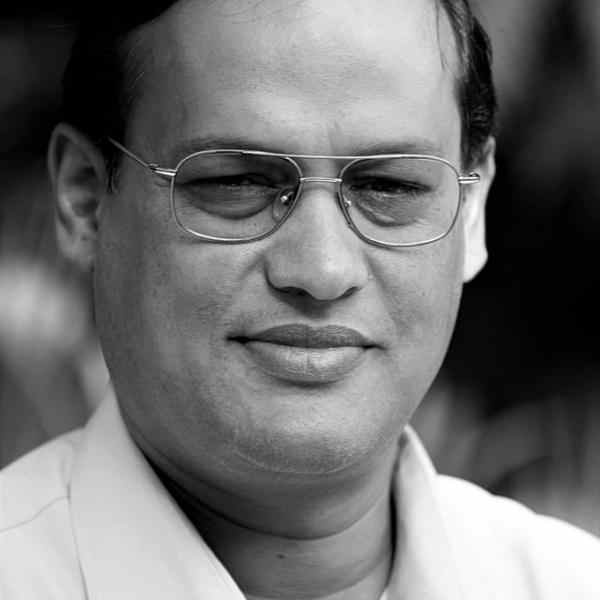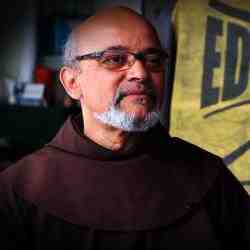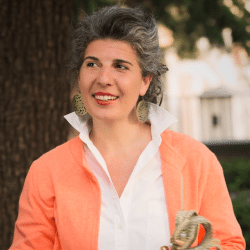Introduction
Chris is ending the cycle of violence and building peace in North East India, by addressing the dual causes of conflict- absence of communication channels between opposing groups and lack of development opportunities, through his unique solution of “Peace Through Education.”
The New Idea
Brought up by a naturalist grandfather and a pianist grandmother, when posted to the insurgency ridden North-East India as an army engineer, Chris undertook a personal exploration of the culture, language, food, music and wildlife of the region.
His empathetic understanding of the region, its socio-political history and people made Chris realise that the endemic reason for conflict in North-Eastern states of India--between tribes, hill tribes and the people of the mainland, and the people of the North-East and the Indian Army, is two-fold. First, the lack of communication between the groups, perpetuates historical conflicts. Chris realises that currently opposing groups see each other as “group of others,” making presumptions not based on facts. Chris believes that if there are systems for people to truly communicate with each other, they will understand each others’ realities, see each other as individuals and empathise with them. Second the absence of socio-economic opportunities for children and youth makes joining militia groups the most attractive option. Chris believes that by triggering development in these areas that will provide education and employment to the young people, he can prevent the continuation of the cycle of violence.
In an ingenous single solution that solves both these problems, Chris is creating platforms for conflicting groups to come together, communicate and work together for the development of their communities. In spite of opposing opinions about politics or other issues, development of the village is a shared purpose among all these conflicting groups. Chris uses this one common agenda they have to bring them together to build schools, community centers, teaching and create jobs. In the process resources are built in the community and socio-economic development is triggered, and relations of friendship and peace are built between historically conflicting groups.
From the North-East of India, Chris is now scaling his model to other areas with latent conflict, like Kashmir, Myanmar and Northern Sri Lanka.
The Problem
The seven North-Eastern states of India, Assam, Manipur, Meghalaya, Tripura, Mizoram, Nagaland and Arunachal Pradesh, used to be independent Kingdoms, until they were forced at gunpoint to join the Indian Union when India gained independence from the British in 1947. Owing to this, and the fact that the people of the North East have more Asian than Indian features, very different cultures and languages, the people never truly felt like a part of India union. To this was added the dissatisfaction of very little development funds and activities channelized in these areas by the Indian central government. These states are mountainous and hard to access for development activities, and are sparsely populated, therefor have a low Parliamentary representation to lobby for development schemes for them.
As a result, several underground insurgency movements erupted in the North-East in the 1960s with the demand of becoming a separate nation. To thwart this violence and separatist agenda, the central government imposed military rule in these areas, which, instead of ending the violence, led to further conflict between the state’s army and the people of the North-East, resulting in severe human rights violations and killing on both sides.
Simultaneously, there have been inter-tribal conflicts between the hundreds of different tribes present in the North-East for historical reasons of land, water and natural resource conflicts and superstitious beliefs of tribal leaders. The tribes live in mutual geographical isolation, avoiding interaction with other tribes.
The conflict between the tribes and between locals and the army is perpetuated for two reasons. First, the absence of any opportunities for the conflicting groups to communicate in order to resolve their conflicts. Second, the lack of socio-economic development in the area, for which the locals blame the policies made by the central government, which exclude them or do not address the issues they face on the ground, further aggravating the isolation the people of the North East feel from the mainland and its people.
The Strategy
Chris consciously chose repeated posting in the conflict-ridden North-Eastern states of India because the more he understood the root cause of the conflict as a lack of communication between opposing groups, the more he wanted to bring peace to the area by building empathy between these groups. Chris started by engineering a mind shift change within every rank of the Indian Army to make them realise that their job of maintaining peace became easier if they were friendly towards the people, rather than violent and abusive.
During his time serving with the Assam Rifles unit, his conversations with the local people made him realize that they felt alienated from the armed forces because most of the soldiers from the mainland were Hindu and did not appreciate the local Christian festivals; their food and culture was very different and there had so far been no attempts to get to know each other. As a beginning to remedy this, Chris got local artisans to make life size statues of the Nativity and had them displayed in the most prominent public places with a banner that read, “Assam Rifles Wishes You Merry Christmas.” To follow this up and showcase the armed forces as friends of the people and harbingers of peace, Chris organized the first ever celebration of the Peace Accord that had been signed between the Indian Government and the rebel groups. The Assam Rifles sponsored and organized celebrations with games, food stalls, cultural shows and fireworks, was a huge sign of the commitment of the forces towards maintaining peace in the area. In addition, the celebrations had brought the people and the soldiers together to learn about each other’s culture, food and form friendly relations.
Chris recognized that the only way for conflict to end was for people to shift from focusing on differences to seeing what they had in common. To find a shared purpose between tribes, army, religious and other groups, in 2013 he started working in remote rural communities in the North East and tested different development initiatives like microfinance lending to women’s groups, providing nutritional supplements to children, orchard and kitchen garden plantations. After a year of experimentation, he discovered that education is an issue that all groups prioritized and were ready to contribute towards. Education, thus, became the vehicle for bringing these different groups together on the same platform.
At the same time, Chris built alliances with tribal chiefs, the Bishop of Manipur and other influential leaders to buy into the idea of bringing peace through bringing diverse groups together. These leaders became mouth pieces for Chris’ mission and introduced him into communities so that he could have easy access and trust to start working in the communities. Such leaders, mobilized local communities to contribute natural resources they could gather like stones from the fields, wood and bamboo from the forests. Chris simultaneously convinced the Armed Forces to spare construction materials like sand and cement, asbestos sheets, and use of heavy equipment like bull-dozers and cranes. He brings these two groups together to contribute resources, time and effort to build schools, hostels, libraries, community resource centers, bathrooms and other education infrastructure. While they work together the soldiers learn to respect the local wisdom of the villagers, and the villagers see the soldiers as those helping them develop their community. During the construction period these two groups who have had no opportunity to speak to each other before this, other than in a hostile interrogation, learn about each others’ way of life, problems each faces, their aspirations. They cook and eat together. Chris encourages both the communities to do cultural performances for each other in the evenings. A sense of friendship and camaraderie is built between these two warring factions.
Even after they stop working together, the people continue to communicate, because the mental barrier to speak to each other has been broken. If there are cases of violence and the army needs to investigate, instead of arresting and beating the villagers and interrogating them in a hostile environment, the army can now ask them in a friendly manner, and the people too are ready to volunteer any information they know, because they now understand that both of them want the same thing- peace in the region.
Seeing incidences of violence and attacks on the Army significantly drop in these areas, the army now sees value in planning community outreach programs themselves. The army is now opening up the army base clinic to all civilians, the army unit’s doctor doing health and hygiene awareness classes in the schools every week. There has been a stark mindshift change in every rank of the armed forces, from the high ranking Brigadier, to the young soldier, that by being friendly and helpful towards the people, rather than by using force, they are making their own job of maintaining peace in the area easier. Chris has involved 15 different battalions of the Assam Rifles and Indian Army regiment in working with the communities.
In order to enable communication between the different tribes and the mainland population, Chris has created various platforms for the children and youth of different groups to come together, like, studying together in mixed tribe schools, treks, meditation and exposure field trips to each other’s communities. In the 4 community centers, 1 school and 1 hostel including 12 bathrooms Chris has facilitated building of, with around 650 children studying in them, by design there is a mix of 7-8 tribes of children studying together. This is much harder to achieve than have children from the same tribe in the school, because children from different tribes live far apart and they and their parents have to be convinced to travel the long distance to school, stay in a hostel, and most importantly, be with children from who they consider an “enemy” tribe. However, Chris’ initial realization that the community values education as the only means to improve their lives, comes in handy in convincing parents, because they overcome their mental barriers for the sake of providing their child with a quality education. Through these activities, Chris is ensuring that the new generation of the North-Eastern people learn about each other’s cultures and practices, understand each other and coexist in peace.
Chris also builds relationships between people in the mainland and the tribals by having people from the mainland sponsor the education of children from the poorest families. The tribals, who have so far perceived of people from the mainland as aliens whose country they do not want to be a part of, now see them as their supporters to bring the development to their areas that they have been so far deprived of. Chris encourages the sponsors to communicate regularly with the children and their families they have been paired with, by updating on the child’s growth and performance, and sharing how each others’ lives are.
Once the young form bonds, Chris uses the influence on their families to bring together their parents and other adults of the community in a “Friendship Festival”, where through cultural performances, traditional sports competitions, cooking together and eating each other’s food, the tribes pledge friendship with each other. Chris targets the most influential people in these groups, from tribal leaders to movie stars and popular musicians from the mainland, to come perform in the festival and become mouth pieces promoting friendship and peace between the people. Since its launch in 2015 the Friendship Festival brought together nearly 1000 people from tribal villages, mainland and the army, where 33 tribes pledged friendship, post-which no incidents of violence has been recorded between them.
In the 16 areas in 3 states that Chris works in, through his organization, Sunbird Trust, there are 650 children from different tribes and the mainland studying together in the schools he has supported through his initiatives. Chris aims to educate 10,000 children studying together from across tribes by 2025 through the support of the different groups he has brought together. Simultaneously, he also plans to build employment opportunities for those finishing their education, so they can contribute back to their communities and the Sunbird Trust. Even in these early stages 3 Alumni who got the Sunbird Trust’s education support are already contributing towards the education of more children from their villages. Next, Chris plans to scale his model of building empathy between conflicting groups to other regions with an underlying threat of violence erupting, like Kashmir, Myanmar and Sri Lanka.
The Person
Chris’s father worked with the Indian Airforce and was posted to remote locations. So, Chris’ parents left him with his grandparents in Bangalore. Chris is deeply influenced by his Naturalist grandfather and pianist grandmother, and grew up with a love for nature and a great musician himself. Although he wanted to study agriculture and even got admitted in college to do so, his family pressured him to join the army.
Chris became an engineer in the army, specializing in building bridges. Early on in his career he was posted to the highly volatile and conflict-ridden North-East of India. Whenever there was a natural disaster in the country, Chris always went to the area immediately to volunteer for emergency relief. Because of his love for nature, music and culture, Chris spent all his time interacting with the communities around his barracks, learning about his surroundings from the people. He even brought his wife to his posting, that no other officer did since it was considered so dangerous; and they travelled around these communities with their two young children, because the people had gotten to know Chris and assured him and his family safety.
Because of his close personal relations with the people in the communities, and his understanding of the culture, Chris became the go-to person within the army for resolving conflicts and sticky situations the army got into with the local underground groups or communities.
During his last four years of service, Chris requested a posting in the Border Roads Organisation (TBRO), because as a Colonel in the Army he had many restrictions to his movement, and who he could speak to. As an officer in the TBRO he could wear civil clothes and move around freely amongst the people. Chris used these liberties to visit remote and far flung communities in the North-East and get to know the people and their perspectives there. He realized that the lack of development of education and employment opportunities for the young people was pushing them to join the underground movements and perpetuating the cycle of violence. First in his individual capacity and then garnering support from friends, Chris started sponsoring and supporting the education of children from the poorest families in these areas.
Chris retired from the Army as a Colonel on 31 January 2016, registered the Sunbird Trust, and started working full time on bring peace through education in the North-East of India.




